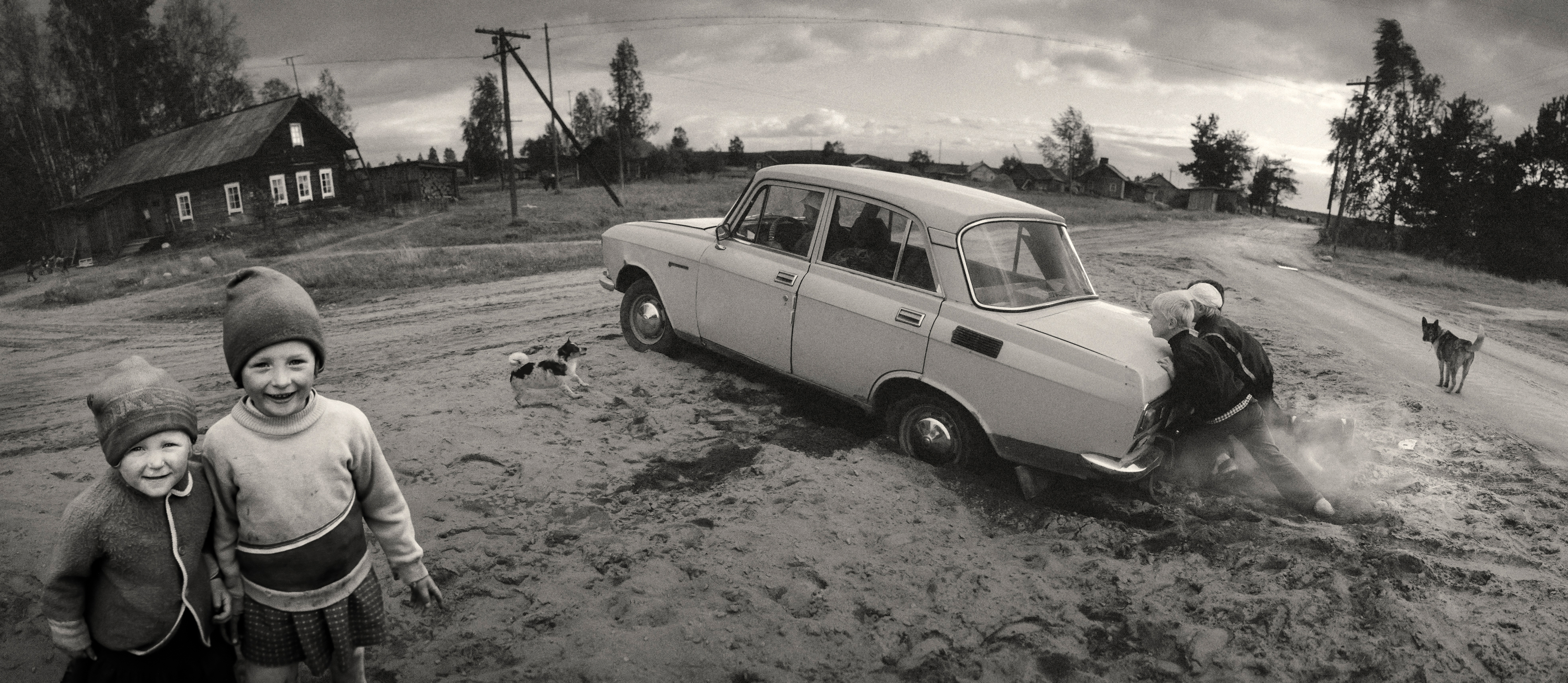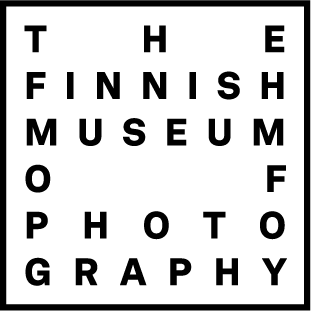
Four children, two dogs, and one Moskvitsh. A junction of dirt roads, a log cabin, the sun appearing through the clouds gilding the view. Two of the children are pushing the car, which is stuck in the sand, while two other children have come closer to the photographer and his camera. One dog is jumping up and down next to the car, while the other one, with a turned head, views the situation from farther along the road. In the panoramic photograph by Pentti Sammallahti, there is ‘a situation going on’.
A book, published in 2012, presenting a wide overview of Sammallahti’s work, was named Täällä kaukana (‘Here far away’). The clever name highlights Sammallahti’s role as a world traveller and his ability to bring these distant environments of his photography expeditions close to the viewer, creating an immediately familiar feel. Sammallahti travels to the ends of the earth with his camera, capturing moments for us to see – this time, we get to be part of a car crisis at a crossroads in Karelia.
The photographs in Sammallahti’s The Road through Russia series are easily associated with remote countries. Some of the photographs were taken as far away as Siberia. The shooting location for this photograph, however, is Vuokkiniemi, a village just 70 kilometres away from the S-Market shop in Suomussalmi, a Finnish municipality that borders Russia. The viewer may see in the photograph an archetypal, anonymous village road in Russia, but in fact, we are in the heartlands of Finnish national culture and the story of Finnish art. This time, we are ‘here close by’.
Before Sammallahti arrived, Vuokkiniemi had been visited by Finnish researchers and artists since the 1820s. Elias Lönnrot documented poems there, which were to form a central part of the Kalevala epic – and he discovered the name Kalevala itself, deciding to make it the title of the entire epic. In the 1890s, the photographer I. K. Inha captured the culture of sung poetry that was waning in the region at the time, and through his iconic photographs, he added the Vuokkiniemi villagers as part of the history of Finnish photography.
Luis Sparre, a contemporary of I. K. Inha, visited Vuokkiniemi on his honeymoon in 1892, and described the region in his book Kalevalan kansaa katsomassa (‘Visiting the Kalevala people’) as follows:
“The villages of Vuokkiniemi and Uhtua, which are often mentioned in connection with White Sea Karelia, are the largest and most important settlements in the entire Archangel government, except for the coastal region. Judging from the descriptions we had, we expected Vuokkiniemi to resemble a town, but from afar we could see that this was a false expectation. A large part of the village, comprising thirty houses, is located on open, sandy soil, and centred around a small white church.- -”
There is no white church in Sammallahti’s photograph, and neither does it show the temporary houses hastily built at the end of the 20th century for people forcefully moved to the village. The landscape does not seem to have changed much since Sparre and Inha’s times.
In a text published in 1996, Jukka Mallinen describes Pentti Sammallahti’s The Road through Russia series as nostalgic – the photographs in the series give centre stage to “indigenous” people and timeless environments, with only a comic side role reserved for contemporary symbols. The Moskvitsh may be at the centre of the image, but it certainly does not represent the omnipotence of technology. The heroes of Sammallahti’s story are the dogs and the children, both appearing to be semi-wild and joyously full of life. These are the people of the Kalevala; at least, this is likely, as 85% of Vuokkiniemi’s inhabitants are Karelian.
Since Sammallahti’s photograph was taken Sammallahti, the people of Vuokkiniemi have been immortalised by the photographer Jaakko Heikkilä in his series Kitchen Talks, in 2013. In an Yle (Finnish Broadcasting Company) interview in 2014, Heikkilä said that the starting point of his work is Lönnrot’s poetry collection trips, and that his own aim is to capture “something like a poem of our time, that is, very sensitive, poetic images of the cabins.”
In the 1990s, the Karelia region in Russia was opened to travel, following the era of the Soviet Union. In addition to photographic artists, other Finnish people have found their way there, and today, Vuokkiniemi is visited by busloads of tourists every year, some of whom have been returning there for decades, to see the people of the Kalevala. Some are looking for their roots, and others for something more authentic than their everyday lives. The life of the village, the cabins and the crossroads are today being captured by hundreds of camera phones. Countless stories have been told through Vuokkiniemi and its inhabitants, and it is likely that we have not heard the last one.
Anni Wallenius, chief curator, collections
References
Laukkanen, Sarah 2014. Iloisuutta ja säröjä – katso kahden Karjalan kuvat. Yle Kotimaa 7.2.2014. https://yle.fi/uutiset/3-7072720
Mallinen, Jukka 1996. Maan vahvuus, in the book Pentti Sammallahti. Musta taide 4/96.
Sparre, Louis 1930. Kalevalan kansaa katsomassa. Muistiinpanoja Kauko-Karjalan-retkeltä v. 1892. Toinen painos, Kainuun Museoyhdistys r.y. 1984.
Trane, Finn 2012. Foreword in the book Täällä kaukana. Opus 2012.
Jaakko Heikkilä's series Kitchen talks (2013) can be viewed in his website: http://jaakkoheikkila.ax/gallery/karjala/
